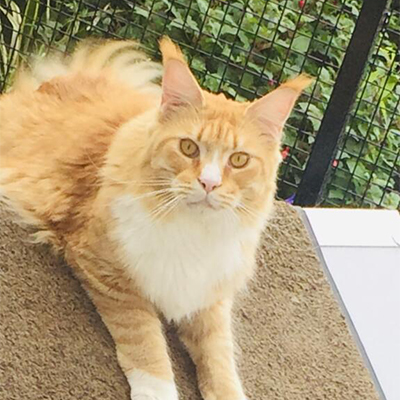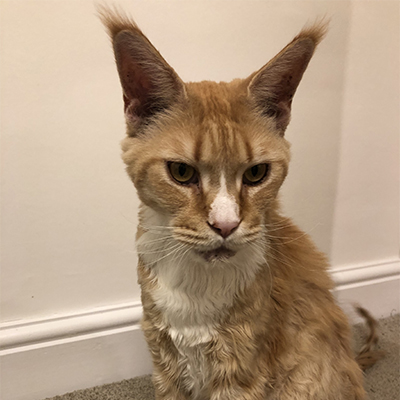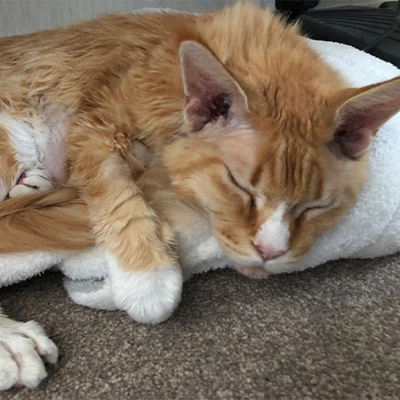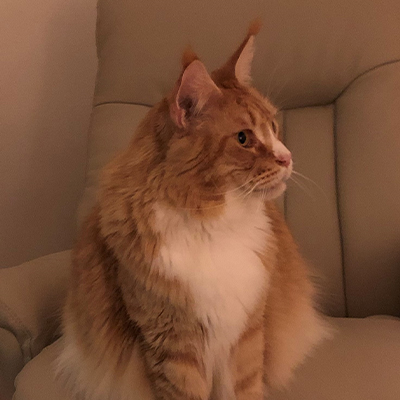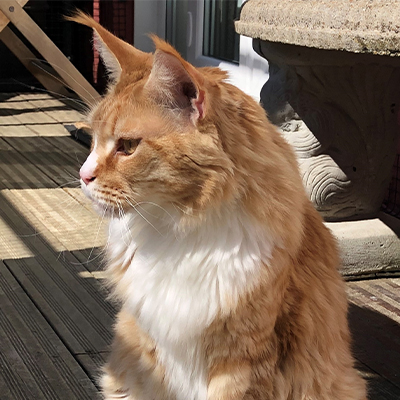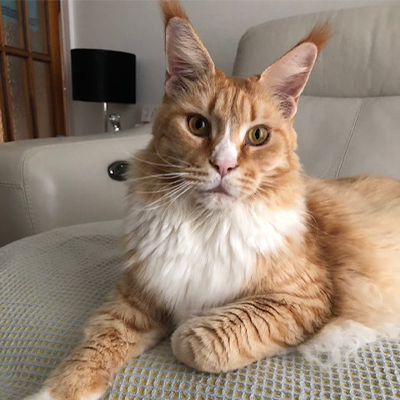
Darcey's story:
A story of hope and happiness
Darcey was diagnosed with nasal lymphoma and she was treated with chemotherapy. Just scroll down this page to find a link to Darcey's Diary after reading a bit about nasal lymphoma.
Nasal lymphoma in cats
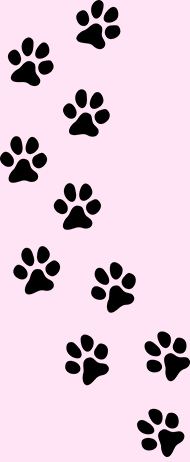
Lymphoma is the most common cancer found in cats and represents about 90% of all feline blood cancers. Lymphoma is a malignant neoplasm affecting lymphocytes, a type of white blood cell, and lymphoid tissues throughout the body. It is more correctly called lymphosarcoma (LSA) as it is a type of cancer. Lymphoid tissue is normally present in many places in the body including lymph nodes, spleen, liver, gastrointestinal tract (GIT) and bone marrow, and LSA can occur in all of these locations as well as other extra-nodal sites such as skin, nose, kidneys, brain and spinal cord.
Nasal LSA is the second most common cause of chronic nasal disease in cats after chronic. While nasal LSA is an uncommon presentation in feline lymphoma cases, accounting for less than 1% of all feline neoplasia, it is the second most common extra-nodal form of LSA after alimentary or gut lymphoma. It is the most common nasal tumour seen in cats, representing half of all nasal neoplasia, followed by adenocarcinoma, squamous cell carcinoma and fibrosarcoma. The most common nasal tumour in dogs is nasal adenocarcinoma which originates from the glandular cells (such as sebaceous glands) in the nasal cavity.
The reason why a particular pet may develop any cancer is not straightforward as very few cancers have a single known cause. Most seem to be caused by a complex mix of risk factors, some environmental and some genetic or hereditary. While the cause of nasal LSA in cats is unknown, the disease in humans has been associated with Epstein-Barr virus infection. Feline leukaemia virus (FeLV) infection has been associated with increased risk of developing lymphoma in the past although the incidence of FeLV has decreased in the past few decades and most cats with nasal lymphoma are now FeLV-negative. Environmental exposure to tobacco smoke has been shown to be a risk factor for nasal tumours in dogs but this has not been shown for nasal tumours in cats, although it has been reported that there is an increased risk of lymphoma in cats exposed to environmental tobacco smoke.
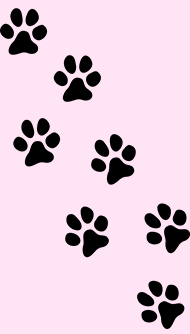
Treatment
Treatment is based on the use of radiation therapy (radiotherapy), chemotherapy or both; however, it is unclear which approach is most effective. LSA is sensitive to both radiotherapy and chemotherapy, and your veterinarian (or veterinary oncologist) will make recommendations on the best course of treatment for your pet. Given that LSA is usually a systemic disease, if tests cannot rule out the presence of disease elsewhere in the body, then chemotherapy is often pursued instead of radiotherapy.
The exact chemotherapy drugs and schedule used depend on the goal of treatment, how aggressively the cancer is behaving, how sick an animal is at the start of treatment and any abnormalities in organ function (particularly kidneys and liver). Chemotherapy is most effective when we use a combination of drugs so most protocols use 4 to 6 different drugs in a multi-drug protocol (such as COP or CHOP). Initially, treatments are given more frequently (such as once weekly) and then, depending upon the response and protocol used, are gradually spread out and/or discontinued. Other options for therapy may consist of using a single chemotherapy drug (single agent therapy) at 3-week intervals or palliative care which is simply designed to keep your pet comfortable at home using less toxic drugs to provide as good a quality of life for as long as possible. A disadvantage of single agent therapy is that remission rates and expected survival times are much more difficult to predict. Blood tests, radiographs and/or ultrasound scans are generally repeated at to monitor for side effects (such as a low blood cell counts) and to determine response to treatment.
If a patient comes out of remission or relapses, we can try to put them back into remission using either new combinations or doses of the same drugs or different drugs. While the chances of obtaining a second remission are lower, there are some cats that do respond well and have additional time with a good quality of life.
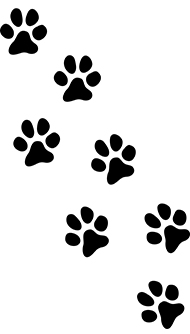
Conclusion
Nasal LSA in cats is treatable, with a high response rate and long survival time, particularly when a multimodal therapy approach is used. Since no gold standard treatment has been established for feline nasal LSA, a case-by-case approach is normally used for each patient. Treatment is often based on the veterinary surgeon or oncologist's experience and is usually tailored to each patient, considering extension of the disease, anaesthesia risks, concomitant diseases, affordability and owner preference.
In the words of Nic and Tracey:
Darcey is our much loved, big and fluffy Maine Coon. She is very much head of the menagerie in our household and is always strolling around looking for Dreamies and head rubs. At the time of Darcey's cancer diagnosis, she was just over 3 ½ years old and apart from suffering from some mild hip issues, had no prior health concerns. Her cancer diagnosis came as a complete shock to us which left us just shattered.
Thankfully, Darcey is now in remission. For how long, we just don't know but we are absolutely delighted that she has come through this and that we are able to spend as much time as possible with her. Throughout the diagnosis and treatment there are times that she has been a little poorly and under the weather, but nothing that would have warranted us taking a different course of action. As much as we absolutely adore her, we would not let her have a poor quality of life.
Read More
One of the main issues that we faced whilst Darcey was going through diagnosis and treatment was the lack of real information out there for owners. There are many accessible veterinary and medical articles which are complex and jargon ridden, however in terms of day to day guidance and what to expect, we struggled. Fortunately, through friends in the cat fancy we were able to hear some similar stories, but not many cases where chemotherapy has been pursued. As well as the practicalities of treatment, there is no denying that chemotherapy is expensive. In our case, we had used the vast majority of our annual insurance cover on her diagnosis, however this was a particularly tricky cancer to diagnose and in most cases, an adequate insurance plan would cover all costs.
Our “Darcey Diary” gives a bit of insight into her journey to remission:-
October 2018
On return from holiday our cat sitter advised us that Darcey seemed to have had a bit of a runny eye and nose. We take her round to our local vet who prescribes a course of antibiotics. This seems to clear the issue up and no further treatment is needed.
February / March 2019
We notice that Darcey has again got a runny nose but this time there is some blood visible in the mucus. A further course of antibiotics is prescribed and swabs were sent off, as well as a head x-ray being taken. The course of antibiotics has not cleared the discharge and the swab results / x-ray do not identify anything. After discussions with our vet, they would like to refer Darcey to the RVC for further investigation rather than try a different treatment. We agree and a referral is progressed.
March 2019
Darcey is assessed at the RVC and has a CT scan and Biopsy Samples taken. This resulted in no confirmed diagnosis however they tell us that there is unilateral nasal discharge (from the right nostril). Advanced imaging and cytology have indicated a suspected lymphoma (a mass like lesion is visible) but tissue sample and biopsies have not proven this, and it would be quite unusual for a cat of Darcey's age to suffer from this type of cancer. Severe inflammation is present in the nasal passage and so doxycycline has been prescribed. We agree that we will return in 4 weeks to repeat the CT scan and biopsies. At this point we feel delighted that there is no cancer diagnosis but still very nervous as to what this could be.
April 2019
Initial results from the doxycycline have been great. The discharge is clear and no symptoms are visible, however 2 weeks after the consultation at RVC, Darcey takes a turn for the worse. We notice that her throat is sounding quite raspy when she breathes and she is increasingly breathing through her mouth, with her nose seeming to be quite blocked up. We take her round to our local vet who places her in the oxygen tent for a few hours each day of the weekend which seems to help. Our local vet contacts the RVC for guidance and their preference is that when they repeat the CT scan and biopsies later in the month, they would prefer to do so without any other medication in her system, which may affect the results. Obviously if her situation deteriorates further, we are to take her in. In the meantime, we buy a nebuliser and humidifier for her room to help aid her breathing comfortably. For the next week and a half, we are very worried but keep a close eye on her. Her appetite is waning a little.
Later that month, Darcey re-attends the RVC for a second CT scan and biopsy sample – our fears are confirmed. Darcey is discharged with confirmed intermediate to high grade nasopharyngeal lymphoma. The imaging on the second CT scan shows that the mass has now spread across, almost entirely blocking both nasal passages, which explains her recent issues with breathing. Steroid treatment is prescribed to address immediate inflammation and commence a baseline therapy. Chemotherapy and Radiotherapy are discussed as options and we will be referred to a local clinic to discuss further. Feel utterly devastated, lost and not sure what to do for the best. Also feel very angry that life is just not fair. As long as Darcey is not suffering then we agree to do everything that we can to help her try and get better.
Our referral is classed as urgent and we have a consultation booked in with Southfields Veterinary Specialists to discuss treatment options – Radiotherapy v Chemotherapy. The conversation is a bit of a daze but my very basic understanding was that Radiotherapy can be used to treat specific areas on the body for targeted treatment. Chemotherapy will target all cancer that is detected in the body.
There would also be differences in the way the treatments are administered. For Chemotherapy, after each treatment, which would be over a course of 25 weeks, Darcey could come home. For Radiotherapy, Darcey would have to stay in the veterinary hospital for 5 days at a time until the treatment course had completed, being able to come home at weekends.
In our case, we are going to have to opt for chemotherapy. Because we started immediately with steroids following the diagnosis to assist with her breathing, it may have masked cancer in other parts of the body and so the safest option, in case it had spread, is to treat with chemo. It is explained that each cat can react differently to this treatment, although it does not normally have such an impact on the cat as there is seen in humans, due to differences in dosage. We also need to understand that this may or may not be successful and even if successful, there is no guaranteed time period for remission. The cost of a 25 week period of treatment for Darcey is estimated to be around £3000 - £4000. This is all ok with us, we just want to give it a try. Darcey will have an appointment every week for the first four weeks and will then move to appointments every three weeks.
Treatments
After 11 treatments, today is her last treatment we hope! Darcey will have a full body CT scan today as well as some samples taken from her lymph nodes. She will also have samples taken from her liver and spleen to check for any concerns. If all is well, she will receive her last chemo treatment. It's going to be a long wait as we have to leave her there all day.
We get the call to go back and pick her up. The 5 minutes in the waiting room seems to go on forever. The initial results are great though! The scan is still clear with no lymphoma visible. Her liver and spleen results will be back tomorrow. There is a very small shadow showing on her lungs, however this is suspected to be due to the position she is lying in for the CT scan. Her lymph nodes are fine.
Now we just wait for a call tomorrow, which turns out to be the best news possible - no concerns with her liver and spleen. Darcey is in remission! We can't quite believe it. We agree to re-scan her in 3 months' time to check how everything is going and also ensure there is no change to her lung.
Again following the treatment, she has a temperature but we are now more aware to look out for it and quickly get her onto antibiotics. The consultant explains that after a long course of treatment, some cats can become less tolerant to the medication, however her symptoms have been slight and she has not appeared distressed.
Looking Forward
It has now been 6 weeks since Darcey's last appointment and she is going from strength to strength. She is back to weighing over 7.5kgs, her fur is now coming back in, and we have been following ‘whisker watch' very closely - new whiskers are appearing every day!
Trying to get her off the contraband food may prove more difficult. I'm not going to break it to her!
We are not naive in this process – we realise that the treatment has only given her, and us, a temporary reprieve. The total cost to date is close to £10,000 and we have had a few worrying moments along the way, however we wouldn't change a thing and we would do it all again. We couldn't have asked for her to be in better hands at Southfields. Her consultant has been there for us every step of the way and put up with our never-ending questions.
Darcey deserved us to fight for her, and whilst she is tolerant to the treatment and well in herself, we will always fight for her. I'm sure that she is probably fed up now of the endless hugs and cuddles she is being given every time that she walks past us, but for us, there will never be enough cuddles
The most recent photo shows Darcey recovered and enjoying some nap time with her mascot!
Hide

Get in touch
You can find information and advice on animal cancer support here, or feel free to contact us directly:
Call: 07376 213733
Email: hello@actcharity.co.uk

